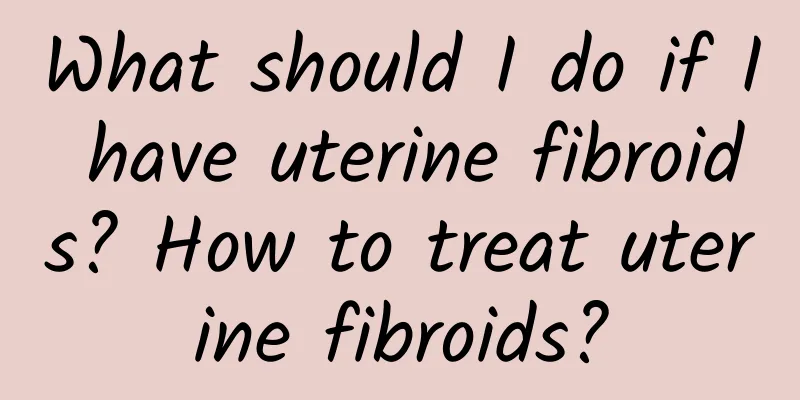What should I do if I have uterine fibroids? How to treat uterine fibroids?

|
Uterine fibroids are common benign tumors that grow in the female reproductive organs. Since the female uterus is an important organ related to female reproductive health, we should know what are the symptoms of uterine fibroids in women? c should be treated in time to avoid affecting women's health. Clinical manifestations 1. Symptoms Most patients are asymptomatic and the disease is only discovered occasionally during pelvic examination or ultrasound. If there are symptoms, they are closely related to the location, speed, degeneration and complications of the tumor growth, but have relatively little to do with the size and number of the tumor. People with multiple subserosal fibroids may not have symptoms, but a small submucosal fibroid can often cause irregular vaginal bleeding or menorrhagia. Common clinical symptoms include: (1) Uterine bleeding is the most common symptom of uterine fibroids, occurring in more than half of patients. Among them, cyclical bleeding is the most common, which can manifest as increased menstrual volume, prolonged menstrual period or shortened cycle. It may also present as irregular vaginal bleeding that is not related to the menstrual cycle. Uterine bleeding is more common with submucosal fibroids and intramural fibroids, while subserosal fibroids rarely cause uterine bleeding. (2) Abdominal masses and compression symptoms When the fibroids gradually grow and cause the uterus to enlarge to more than the size of a 3-month pregnant uterus or become a large subserosal fibroid located at the fundus of the uterus, a mass can often be felt in the abdomen, which is more obvious in the early morning when the bladder is full. The mass was solid, movable, and non-tender. When the fibroids grow to a certain size, they can cause compression symptoms of surrounding organs. Fibroids on the anterior wall of the uterus close to the bladder can cause frequent urination and urgency; giant cervical fibroids compressing the bladder can cause difficulty in urination or even urinary retention; fibroids on the posterior wall of the uterus, especially those in the isthmus or posterior lip of the cervix, can compress the rectum, causing difficulty in defecation and discomfort after defecation; giant broad ligament fibroids can compress the ureter and even cause hydronephrosis. (3) Pain: Uterine fibroids generally do not cause pain, but many patients may complain of a feeling of heaviness in the lower abdomen and pain in the waist and back. When the pedicle of subserosal fibroids is twisted or uterine fibroids undergo red degeneration, acute abdominal pain may occur. It is not uncommon for fibroids to be combined with endometriosis or adenomyosis, which may cause dysmenorrhea. (4) Increased leucorrhea. Enlargement of the uterine cavity, increase in endometrial glands, and pelvic congestion can cause increased leucorrhea. When submucosal fibroids of the uterus or cervix ulcerate, become infected, or necrotic, bloody or purulent leucorrhea will be produced. (5) Infertility and miscarriage Some patients with uterine fibroids are infertile or prone to miscarriage. The impact on conception and pregnancy outcomes may be related to the growth location, size and number of the fibroids. Giant uterine fibroids can cause deformation of the uterine cavity, hindering the implantation of the gestational sac and the growth and development of the embryo; fibroids compressing the fallopian tubes can lead to obstruction of the lumen; submucosal fibroids can hinder the implantation of the gestational sac or affect the entry of sperm into the uterine cavity. The spontaneous abortion rate in patients with fibroids is higher than that in the normal population, with a ratio of about 4:1. (6) Anemia: Long-term menorrhagia or irregular vaginal bleeding may cause hemorrhagic anemia. More severe anemia is more common in patients with submucosal fibroids. (7) A very small number of patients with uterine fibroids may develop polycythemia and hypoglycemia, which are generally believed to be related to the production of ectopic hormones by the tumor. 2. Physical signs (1) Abdominal examination: If the uterus is enlarged to more than the size of a 3-month pregnancy or has a large subserosal fibroid on the fundus of the uterus, a solid mass may be palpated above the pubic symphysis or in the middle of the lower abdomen. It should be non-tender. If there are multiple uterine fibroids, the mass will be irregular in shape. (2) Pelvic examination: During bimanual and triplicate gynecological examinations, the uterus is enlarged to varying degrees and is irregular. There are irregular protrusions on the surface of the uterus, which is solid. If there is any degeneration, the texture is soft. The signs of uterine fibroids during gynecological examination vary according to their different types. If the pedicle of a pedunculated subserosal fibroid is long, a solid mass can be felt beside the uterus and it moves freely. This situation can easily be confused with an ovarian tumor. The submucosal fibroids descend to the cervical canal opening, and the cervical opening is loose. The examiner can touch the smooth spherical tumor by inserting his finger into the cervical opening. If it has prolapsed outside the cervical opening, the tumor can be seen. The surface is dark red, and sometimes there are ulcers and necrosis. Larger cervical fibroids can cause the cervix to shift and deform, and the cervix may be flattened or moved up behind the pubic symphysis. treat 1. Follow-up observation If the patient has no obvious symptoms and no signs of malignancy, regular follow-up observation can be performed. 2. Medication (1) Gonadotropin-releasing hormone agonists (GnRH-a) Currently, the commonly used GnRH-a in clinical practice include leuprorelin (Enanton), goserelin (Zoleide), triptorelin (Dapiga), etc. GnRH-a should not be used continuously for a long time. It is only used for pretreatment before surgery, generally for 3 to 6 months, to avoid causing severe menopausal symptoms caused by low estrogen. A small dose of estrogen can also be supplemented at the same time to counteract this side effect. (2) Mifepristone is a progesterone antagonist that has been clinically tried in recent years to treat uterine fibroids. It can reduce the size of fibroids, but the fibroids often grow again after discontinuation of the drug. (3) Danazol is used for preoperative medication or treatment of uterine fibroids that are not suitable for surgery. Uterine fibroids may grow larger after medication is stopped. Danazol can cause liver damage and androgen-induced side effects (weight gain, acne, hoarse voice, etc.). (4) Tamoxifen can inhibit the growth of fibroids. However, long-term use may cause enlargement of uterine fibroids in some patients, and may even induce endometriosis and endometrial cancer, so this should be paid attention to. (5) Commonly used androgen drugs include methyltestosterone (methyltestosterone) and testosterone propionate (testosterone propionate), which can inhibit the growth of fibroids. The dosage should be used carefully to avoid virilization. During the bleeding period of patients with uterine fibroids, if the amount of bleeding is heavy, uterine contractants (such as oxytocin, ergot) and hemostatic drugs (such as hemostatic acid, aminobenzoic acid (hemostatic aromatic acid), lizhihemostasis, Panax notoginseng tablets, etc.) can also be used, which can play a certain degree of auxiliary hemostatic effect. 3. Surgery Surgical treatment of uterine fibroids includes myomectomy and hysterectomy, which can be performed abdominally or vaginally, or endoscopically (hysteroscopy or laparoscopy). The choice of surgical procedure and approach depends on factors such as the patient's age, whether or not they have fertility requirements, the size and location of the fibroids, and medical technology conditions. (1) Myomectomy is a surgery to remove uterine fibroids while preserving the uterus. It is mainly used for young women under 40 years old who wish to retain their fertility. It is suitable for patients with larger fibroids, heavy menstruation, compression symptoms, infertility due to fibroids, submucosal fibroids, and fast-growing fibroids without malignant transformation. (2) Hysterectomy is recommended for patients with obvious symptoms, those with malignant fibroids, and those who have no fertility requirements. Hysterectomy can be performed with total hysterectomy or subtotal hysterectomy. For older women, total hysterectomy is more appropriate. The possibility of cervical malignancy must be excluded before surgery. (3) Uterine artery embolization is a radiological intervention method in which an arterial catheter is directly inserted into the uterine artery and permanent embolic particles are injected to block the blood supply to the uterine fibroids, thereby causing the fibroids to shrink or even disappear. UAE is currently mainly suitable for uterine fibroids with symptoms such as abnormal uterine bleeding leading to anemia. Caution should be exercised when choosing interventional treatment for uterine fibroids, especially for those with uncontrolled pelvic inflammation, those who wish to retain their fertility, those with arteriosclerosis, and those who have contraindications to angiography, which should be listed as contraindications to this treatment. 5% of patients may experience premature ovarian failure after surgery, and there are also rare reports of pelvic infections. 4. Focused Ultrasound Therapy By focusing ultrasound waves and raising the temperature locally inside the tumor to over 65°C, the tumor undergoes coagulative necrosis, which in turn has a therapeutic effect. The treatment can cause the fibroids to shrink and relieve symptoms. Indicated for symptomatic uterine fibroids. The advantages are that there are no surgical scars after treatment and recovery is fast. Adverse reactions have been reported including skin burns, adjacent intestinal damage, and hematuria. |
<<: Is cervical erosion easy to cure? How does Traditional Chinese Medicine treat cervical erosion?
>>: Taking stock of various weight loss methods, is essential oil massage reliable?
Recommend
Is autonomic nervous system disorder depression?
Autonomic disorder is a common disease in life. S...
A red pimple on the back
If you have red bumps on your back, it is often a...
The efficacy and function of soapberry fruit
Sapindus mukorossi is a relatively common Chinese...
Can I eat Tremella if I have stomach problems?
Stomach disease is quite common in life, and ther...
The efficacy and function of drinking Poria cocos in water
Job's tears is a very common Chinese medicina...
The efficacy of drinking blue cloth soaked in water
Blue cloth is a green plant of the Rosaceae famil...
Left ovarian pain
If a woman finds that her left ovary is aching, s...
What to do if your child is allergic to tetanus
Tetanus is really a serum antibody that can kill ...
Functions of histone methylation
Everyone wants to be healthy and live a long life...
Hemangioma on the breast
Breast hemangioma is relatively easy to treat in ...
The efficacy of Thuja bracelet
In life, many people know that Thuja sutchuenensi...
White discharge from wound
White secretions from the wound are likely to ind...
Symptoms of premature ovarian failure, these four points are the most obvious
Premature ovarian failure is very harmful to the ...
How to treat pharyngitis and cough?
The most common symptom of pharyngitis is coughin...
What to do with acute gout? How to deal with acute gout attacks
Acute gout attacks often occur regardless of time...









